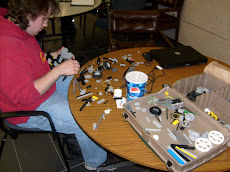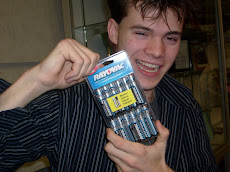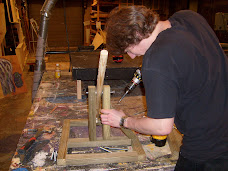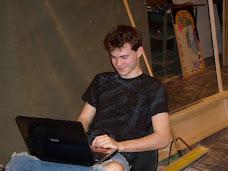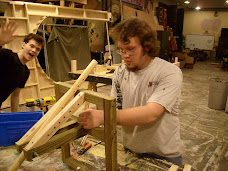Dear Readers,
Hello again, we're glad to have another chance to interest you in learning about our engineering projects. Perhaps you''ll learn something new from our successes and/or failures! This month's project revolves around the field of civil engineering. The problem? To build the best bridge possible!
The Specifics: Of course this IS a college engineering course, so there has to be ridiculous restraints upon what we can build.
Firstly, the bridge can only be constructed from dowel rods and wood glue. Nothing else. It has to span a one meter gap and the trusses underneath can't touch anything (darn!)
Second, the bridge has to have a "road" surface on it so that a block of wood (5 cm x 5cm x 10 cm) representing a car can be able to move along the length of the deck unobstructed from beginning to end.
Third, we have to incorporate a loading platform consisting of a u-bolt and a piece of plywood, which sits underneath the bridge. This will enable the teacher to attach a hook with weights on it, to test the holding capacity of the bridge.
Fourth, the maximum cost of the bridge is only eight dollars!
Fifth, the bridge can't weigh any more than .75kg.
Sixth and final, the bridge can be any taller than 50cm.
Analysis: Well we had to take all of these constraints into consideration when we went through our brain storming process. Even with all of them holding us back, there are still a lot of options available for design of the structure. There are roof-like designs, which are based off of the whole structure being a triangle. These are similiar to arches. And there are the traditional truss bridge shapes, which are usually like parallelograms with lots of triangles inside. The main idea behind designing a bridge to be strong, is to divert the downward weight forces elsewhere. For instance a downward force on the tip of a trianlge divides the applied force in half to both sides of the triangle.
Process: First we chose from our available bridge designs which ones we liked. Then we had to make a build design with measurements of each component for each bridge. This task only requires simple arithmetic skills but it is tedious nonetheless. The point of which is obviously to calculate if the bridge idea would stay within the specifications.
We also have programs at our disposal, which do the more complicated math involving the diversion of the forces. With it we could put a 2-dimentional picture of our bridge in it, and test where the greatest and least stress points would be. With this information it was simple to decide which design we could derive the most strength from.
Our Solution: After much deliberation we ended up building a bridge supported by the Howe truss design. The joints where the dowel rods meet would attach with the tongue and groove method. We chose this because wood glue is stronger than the wood itself, so we want as much surface area in stress points to be covered in glue.
Our final bridge would be light-weight and costly. Both qualities are good because it gives the maximum possible advantages. It has triangles which divert the applied weight force to the central beams of the bridge. We realized that these beams would be taking in the most stress, so we glued the dowel rods together in three's to form the two main meter-long supports. This will make the downward forces work against the large surface area of the lengths of the glued rods. We predict that our bridge will be able to hold the weight of a person!
Thursday, February 21, 2008
Thursday, February 14, 2008
How to best launch a Tennis Ball?
Hello readers,
This is an informational blog created by a group of college students for the purpose of educating high school students on what exactly engineers do. We know that there is confusion in this area for students in high school. So there will be a blog posting for each project assigned to us. It will discuss the engineering problem as it was told to us, our brain storming process, the solution we chose, and a final lookback at the project.
Our group consists of three freshman college students. Michael Graham, Mechanical Engineer. Keith Danaher, Electrical Engineer. Scott Rocca, Theatrical Design and Construction Management.
This was our first project assigned. Problem: to build a Tennis Ball Launcher within certain parameters. The part that makes this challenging is that the bounds of what we can do are very strict. The idea is to somehow propel a tennis ball twenty-five feet and hit a 22" target, centered two feet in the air. We would be given 6 shots at the target within 3 minutes; and grades are based on total number of hits! The devise which must do this has to cost under $8. And it has to be self contained within 18"L x 18"W x 20"H. And finally this miracle machine must be fired with a trigger mechanism.
We considered our options. Compressed air, torsion, springs and elastic cords were discussed among our group as possible methods for launching the tennis ball. After weighing the pros and cons ,we decided to use springs as the main propelling force. Springs would give us a very consistant force variable. Thus we could ideally adjust our machine to shoot and hit the same place every time on the target.
Then after many sittings of discussion combined with drawn out,clay modeled, and computer modeling we had composed our machine design. We chose to make a replica of a "clay-pigeon-shooter." Basically we ended up making a modern catapult.
Next we discussed what type of material to use to build the launcher itself. We quickly decided wood was the most viable option because of its workability, low cost, and good looks.
First we bought a 2"x4"x8' board that we cut in half down the center to double our usable materials and keep a low cost. We built the frame within the maximum parameters first. Then made vertical supports for the pivot arm. The pivot point was supported by 2, 1 1/2" x 1 3/4" boards that had front and side braces to help with the momentum that the swing arm generated. The springs were attached to the end of the swing arm and then to the inside base of the catapult. On the inside base of the catapult the springs are held in place by 2 eye-hooks that were secured into the base. Our machine could be adjusted by moving the place where the springs connect to the pivot arm. We made the adjustments and tested it to see where the ball landed. We used this method of trial and error until we were able to hit a makeshift target that was set at the proper distance. Then we would just hope that our machine would do the same thing every time.
Two conduit clips were screwed into the back of the catapult and a third was attached in to the end of the swing arm under the tennis ball holder. A 1/4" steel rod was inserted between the three clips to form a latch. After loading and aiming were complete, to fire we would quickly remove the rod which would release the swing arm and fire the catapult.
On testing day Mike spoke in front of the class and talked about the catapult. Meanwhile Scott had been in training for firing the devise so he was in charge of shooting. And keith was in full command of ball retrevial.
We ended up hitting the target 4 out of 6 times. We got an acceptible grade and in the end we were satisfied with out work because our project LOOKED better than any other launcher.
The best design was a mimic of a slingshot. It had an adjustible ramp and elastic cords to guide and propell the ball. It used a gate latch for a trigger. They hit the target 6 out of 6 times because their design gave the most consistant shot possible. Bravo.
The most interesting project used air propulsion. A bike pump and PVC pipe. It was shocking because it worked well and got a 4 out of 6 and cost under $8!
All in all was a good test of basic engineering and principals in physics. The project is an introduction into the uses of budgeting, time and material management and project designing.
This is an informational blog created by a group of college students for the purpose of educating high school students on what exactly engineers do. We know that there is confusion in this area for students in high school. So there will be a blog posting for each project assigned to us. It will discuss the engineering problem as it was told to us, our brain storming process, the solution we chose, and a final lookback at the project.
Our group consists of three freshman college students. Michael Graham, Mechanical Engineer. Keith Danaher, Electrical Engineer. Scott Rocca, Theatrical Design and Construction Management.
This was our first project assigned. Problem: to build a Tennis Ball Launcher within certain parameters. The part that makes this challenging is that the bounds of what we can do are very strict. The idea is to somehow propel a tennis ball twenty-five feet and hit a 22" target, centered two feet in the air. We would be given 6 shots at the target within 3 minutes; and grades are based on total number of hits! The devise which must do this has to cost under $8. And it has to be self contained within 18"L x 18"W x 20"H. And finally this miracle machine must be fired with a trigger mechanism.
We considered our options. Compressed air, torsion, springs and elastic cords were discussed among our group as possible methods for launching the tennis ball. After weighing the pros and cons ,we decided to use springs as the main propelling force. Springs would give us a very consistant force variable. Thus we could ideally adjust our machine to shoot and hit the same place every time on the target.
Then after many sittings of discussion combined with drawn out,clay modeled, and computer modeling we had composed our machine design. We chose to make a replica of a "clay-pigeon-shooter." Basically we ended up making a modern catapult.
Next we discussed what type of material to use to build the launcher itself. We quickly decided wood was the most viable option because of its workability, low cost, and good looks.
First we bought a 2"x4"x8' board that we cut in half down the center to double our usable materials and keep a low cost. We built the frame within the maximum parameters first. Then made vertical supports for the pivot arm. The pivot point was supported by 2, 1 1/2" x 1 3/4" boards that had front and side braces to help with the momentum that the swing arm generated. The springs were attached to the end of the swing arm and then to the inside base of the catapult. On the inside base of the catapult the springs are held in place by 2 eye-hooks that were secured into the base. Our machine could be adjusted by moving the place where the springs connect to the pivot arm. We made the adjustments and tested it to see where the ball landed. We used this method of trial and error until we were able to hit a makeshift target that was set at the proper distance. Then we would just hope that our machine would do the same thing every time.
Two conduit clips were screwed into the back of the catapult and a third was attached in to the end of the swing arm under the tennis ball holder. A 1/4" steel rod was inserted between the three clips to form a latch. After loading and aiming were complete, to fire we would quickly remove the rod which would release the swing arm and fire the catapult.
On testing day Mike spoke in front of the class and talked about the catapult. Meanwhile Scott had been in training for firing the devise so he was in charge of shooting. And keith was in full command of ball retrevial.
We ended up hitting the target 4 out of 6 times. We got an acceptible grade and in the end we were satisfied with out work because our project LOOKED better than any other launcher.
The best design was a mimic of a slingshot. It had an adjustible ramp and elastic cords to guide and propell the ball. It used a gate latch for a trigger. They hit the target 6 out of 6 times because their design gave the most consistant shot possible. Bravo.
The most interesting project used air propulsion. A bike pump and PVC pipe. It was shocking because it worked well and got a 4 out of 6 and cost under $8!
All in all was a good test of basic engineering and principals in physics. The project is an introduction into the uses of budgeting, time and material management and project designing.
Subscribe to:
Posts (Atom)


